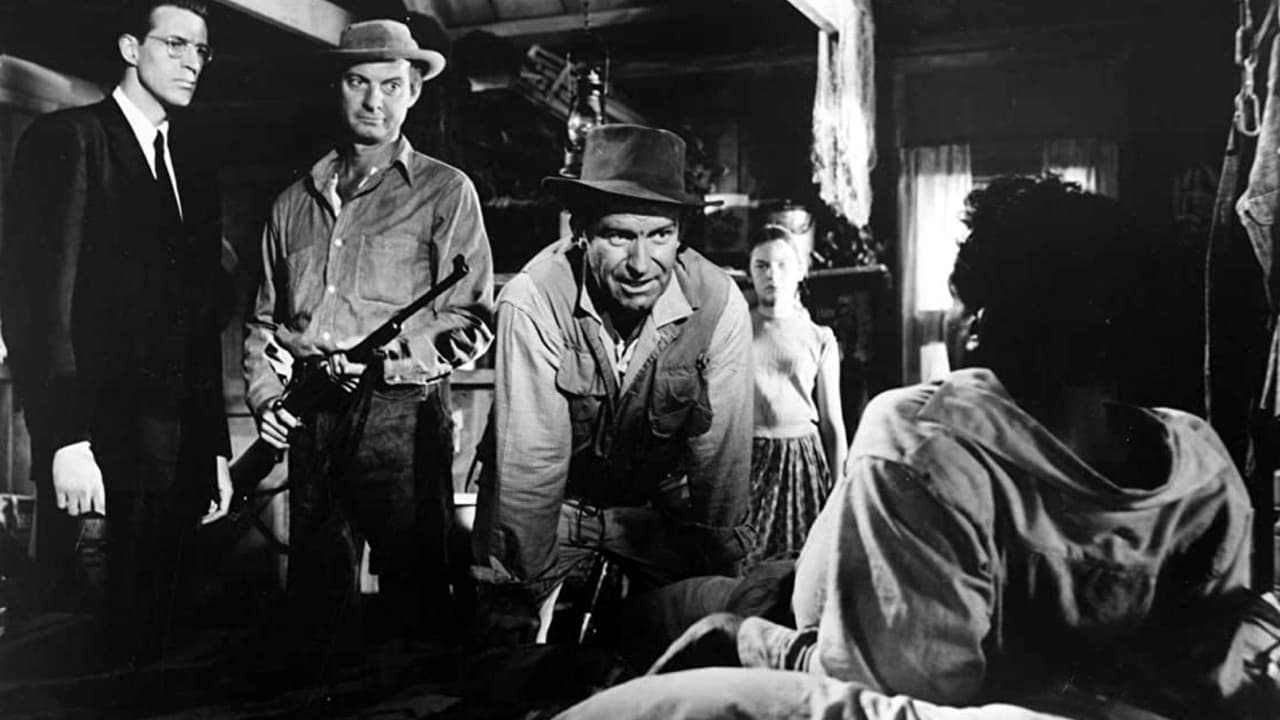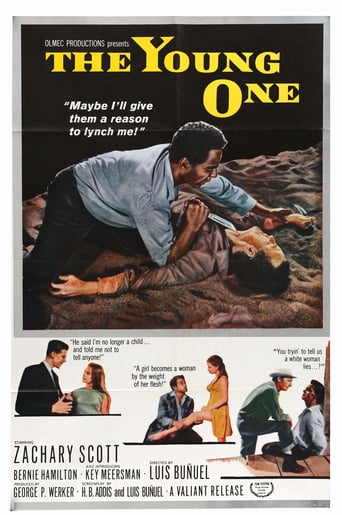

I was totally surprised at how great this film.You could feel your paranoia rise as the film went on and as you gradually learned the details of the real situation.
... View MoreThis is a coming of age storyline that you've seen in one form or another for decades. It takes a truly unique voice to make yet another one worth watching.
... View MoreGreat story, amazing characters, superb action, enthralling cinematography. Yes, this is something I am glad I spent money on.
... View MoreThe joyful confection is coated in a sparkly gloss, bright enough to gleam from the darkest, most cynical corners.
... View MoreThis truly is a masterpiece, lost in the wind of obscurity. As a big Luis Bunuel fan I've seen almost all of his films - that is, except the ones you just can't seem to find anywhere anymore. This is one of those, and I finally found it. What a great and powerful picture. This is Bunuel's second and last film in English; an American/Mexican production mostly known as "The Young One".The entire film takes place on an almost deserted island; a place of solitude that represents the deep south of America. A game warden named 'Miller' lives on this island with the teenage daughter of his recently departed partner, a pretty girl named 'Evalyne'. Slowly 'Miller' is starting to notice that young 'Evalyn' is not a child anymore, at least in his mind. He finds himself very much attracted to her, and starts to 'act out' his forbidden but true desires. The plot thickens when a black man - on the run for being accused of raping an older white woman - enters the world of 'Miller' and 'Evalyn'. The old game warden turns out to be a racist, and wants to kill 'Traver', the black man. However, with young and innocent 'Evalyn' in the centre of the situation things make a different turn, and 'Traver' starts to work for 'Miller', even if he might still be a racist at heart. Then the plot thickens even more when a preacher and another racist are joining in. The preacher finds out there's sexual sin going on between 'Miller' and the young innocent, and he decides to baptize her and confront 'Miller' with his sins. Eventually he shows 'Miller' a way to redeem himself, by 'saving' the girl and the black man.This film is as pure and human as they come. It takes us on a journey to a place where we are confronted with themes like sin; sexual sin, ethnic sin, and existential sin... religion, guilt, mercy, and redemption. In short, all the famous Bunuel obsessions. Yet, this is definitely not an average Bunuel piece. It's very realistic, pure and extremely human. No impressive surrealistic cinematic tricks here. A straight up story about the demons of everyday humanity in modern times. And, I might add... one year prior to Kubrick's "Lolita", which of course has obvious parallels.A forgotten masterpiece that's finally found and available again. A cinefile's dream.
... View MoreThis is a very daring film from famed director Luis Buñuel. While he's famous for the films he made in Mexico and France, this is an American-made film featuring American actors. Here he takes on two hot topics for 1960--racism and pedophilia! While some films from Hollywood were tackling racism, most were very sanitized and featured black actors who were non-threatening--very well-spoken and easy to like. Here, however, the black man is darn angry--something you just didn't see back in films in 1960. As far as pedophilia goes, you never really heard it discussed in films--and the movie was far ahead of its time.The film begins with a black guy (Bernie Hamilton) washing up on the shore of an island in the American Southeast. Apparently he'd been accused of raping a white woman and had escaped on the small boat to avoid a lynch mob. It turns out the island is a private hunting preserve and the white trash game warden (Zachary Scott) is off the island on business. The only other resident is a young girl (about age 12) whose grandfather (and only guardian) just died--who exactly the old man was and how they came to be there is never discussed but you know that the girl has never been off the island and is ignorant of the world. She finds the man and helps him--giving him food and treating him with respect--presumably because she never learned to hate black people.When Scott returns, he tries to kill Hamilton--and it's not even because of the rumor that he raped a woman. He thinks Hamilton has stolen some items...plus in Scott's mind, it's okay just to shoot any old trespasser! But, it turns out Scott is much worse than this--as he soon begins molesting the girl. As for her, she's so sheltered and backward she doesn't quite understand what's happening.There is a lot more that happens after this--most of which is excellent and very compelling. The only negative is the character of the preacher, as Buñuel had a rather pathological hatred of religion. Even though this minister is probably the most likable of any holy man in a Luis Buñuel film, he is totally square and rigid in his thinking--moralistic and a bit dumb. But, he still is basically a very good man (a rarity in these films). His character was simply too one-dimensional--as no preacher is THAT oblivious! Yes, we know the director hated priests and the like, but this did appear to hinder the film's believability--which is a shame, as it's a darn fine film and very, very, very realistic otherwise. And, because it is so well-made and daring, I still strongly recommend you see it, as it's not like anything being made in this country at the time. While some felt this was a lesser film by the director, I actually think it's among his most powerful and best movies. I loved the raw language (back in 1960 and even today it's really tough stuff) and parallel about the white man who could easily excuse pedophilia but couldn't wait to kill the black man!! Wow...gritty.
... View MoreLuis Buñuel who was born in Spain was very well known for his surrealism, some have seen him as the father of it - An Andalusian Dog (1929). He made few English language films and The Young One (White Trash) is one of them. It was filmed in Mexico but takes place in the southern states of the US. If one knows the main subjects of the film, religion and racism, the idea of The Young One might not seem so original. Its plot reminds me a little of Stanley Kramer's The Defiant Ones (1958). But The Young One is a great example how Bunuel is able to make something intense and personal from a conventional subject.The Young One starts when a black man, Traver, suspected from a rape, escapes and runs into a young girl, Ewie (Evalyn). When Ewie takes Traver back to the place she lives in, Traver meets Miller, a man Ewie has been living with since her father died. Miller can't stand black people and he wants to kill Traver for stealing his gun, which Traver actually bought. When a priest comes to the place, Miller has to decide whether to let Traver go or to give him to the mob. To look good or bad in the girl's eyes. As the story goes on we start to see what is hidden under Miller.The film is very enjoyable to watch, it is written very well and the plot is interesting. Even in the beginning one will be hooked, because of how intense it is. The hungry outlaw Traver runs to the lake - grabs a lobster and eats it. The young Ewie stabs on a spider and collects honey from bee hives. This strong sensuality tunes a certain intensity for the film, which is reinforced by the absence of musical score.The Young One makes good observations on racism but basically brings nothing new to one who has seen The Defiant Ones, but it not the purpose of the film. Even that it's basic themes are racism and religion, The Young One goes deeper on morality and youth. Luis Bunuel's movie is a comical survey of these themes, racism and religion, the coexistence of them. Ewie goes to the shower without caring less about the fact that it might awake awkward urges in Traver. Miller brings high heel shoes for Ewie from the town, in which Ewie doesn't feel comfortable at all. Her first experiences of sexuality and adulthood are clumsy. In the same way Bunuel describes Ewie's first experience with religion. Usually films that "bash" religions, might go over the top and showing how amazed people are when they hear of it. But the baptism seems much more suspicious, in Bunuel's eyes, than the act caused by Miller's urges.A fine film about racism, it also describes youth and religion in a brilliant way. It's a poetic film, the girl and the obsessive sensuality, the urge towards the woman. Bunuel leaves the end open, will it be a tragedy or a comedy? The audience gets to decide that. The Young One is a tragical, but also a comical survey of religion and racism, it achieves a new level of cinematic poetry.
... View MoreOn the surface a simple little tale involving a middle aged white man, a young girl whose grandfather has just died and a black fugitive, later to be joined by a gung-ho racist and a priest. But simple, this is not. Beautifully photographed and leisurely told this is a tale of man's inhumanity to man, the corruption of innocence and the very nature of man. The young girl is central to the film and she gives a fantastic performance as she catches the eyes of all the men, yet retains her dignity throughout. It is not really true to consider her totally innocent from the start for she happily takes money for the 'stolen' items and intends to keep the cash for herself. What is more we assume she intends to buy dresses and make-up to make herself more beautiful. Tough though it may seem for her to become aware of such matters so young, we just have to accept it. She is reluctant for her relationship with Miller to become sexual, but not as unhappy as the priest and she has been promised more dresses and significantly a silver pistol, as she gleefully informs him after she survives his baptism. The racial affairs are extremely well portrayed, especially considering this is only 1960. The black character is a completely believable one and likable and seen to be liked by the young girl and eventually even by Miller. The priest (Is this the most sympathetic portrayal of a priest in a Bunuel film?) even offers to stand as witness at any trial. There will be no trial, the fugitive points out to him, showing he has just a little more grasp upon reality. One of the very many highlights in this, for me, was the young girl skipping happily towards the boat with the priest. She is wearing the high heels Miller has given her but she trips gayly along as if playing hopscotch and still, 'just a child'.
... View More